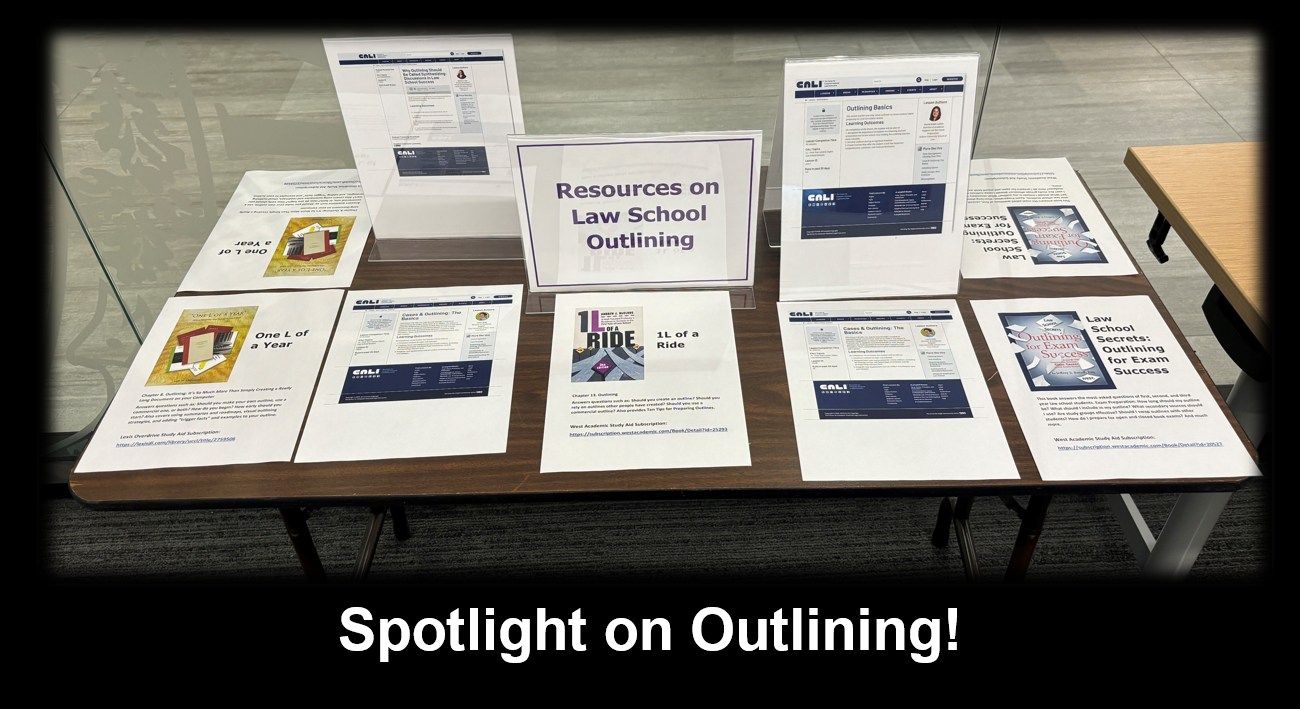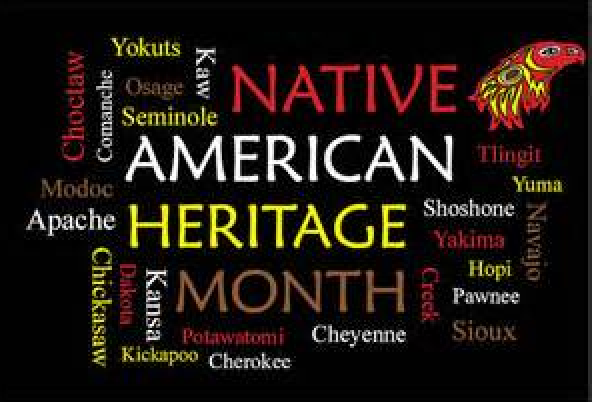This Week in the Law Library ... Nov. 18, 2024
This week in the law library we're teaching advanced legal research and how to research statutes, attending the Schwartz Lecture, highlighting outlining and final exam resources, and celebrating Native American Heritage Month.
This Week’s Research Sessions
Tuesday Nov. 19, 2024
Technology Tuesday
Want to get started on your Canvas page but don’t know where to start? Need some new ideas to make your class more engaging? Law faculty can join Legal Technology & Research Instructional Services Librarian Shannon Kemen's Technology Tuesdays from 12:15-1:15pm.
Technology Tuesdays are 1-hour Zoom meetings for law faculty to join as their schedule allows, to get help with Canvas and other classroom technologies. Law faculty don’t need to come prepared with anything and you don’t need to stay for the entire hour. This meeting is designed to help problem solve issues with classroom technologies, learn about new technologies , and exchange ideas with colleagues. Technology Tuesday videos and notes are available on our Canvas page.
This Tuesday's class will be a Canvas Question & Answer session.
Wednesday, Nov. 20, 2024
Advanced Legal Research Ohio Legal Research
- 2:00pm - 2:55pm
- Room 245
- Ronald Jones, Electronic Resources Instructional Services Librarian & Shannon Kemen, Legal Technology & Research Instructional Services Librarian
Thursday Nov. 21, 2024
Lawyering I, Cohort 1
- 10:40am - 12:05pm
- Room 135
- Shannon Kemen, Legal Technology & Research Instructional Services Librarian
- Researching in Statutes
Friday Nov. 22, 2024
Advanced Legal Research Criminal Law Procedure
- 11:10am - 12:05pm
- Room 245
- Associate Dean Michael Whiteman and Instructional & Reference Services Librarian Ashley Russell
Victor E. Schwartz Lecture in Tort Law
We Used It When We Had It: The Alien Tort Claims Act in Successful Litigation Against 26 Banks for Holocaust-Era Theft in Vichy France
Professor Emeritus Richard H. Weisberg Benjamin N. Cardozo School of Law
Friday, Nov. 22, 2024
12:15pm - 1:15pm
UC College of Law Room 160
Register
The story of the paper trail of “Jewish money” stolen by various European institutions during the Holocaust is a complicated and still incomplete narrative. This lecture speaks to the way that U.S. federal courts assisted in both bringing a firmer factual base to historians and a measure of justice to those victimized by property theft during the Second World War.
During WWII, commercial banks operating under the antisemitic Vichy regime in France confiscated the assets of those depositors recognized as Jews under Vichy law. After the war, many efforts to recover these seized funds (from banks both in France and many other European nations) foundered due to what the banks characterized as a lack of adequate records—essentially once again victimizing the depositors, whose papers had been confiscated and often destroyed by the Nazis and their collaborators.
Beginning in the 1990s, however, a new wave of class action litigation against European institutions successfully broke the logjam. Benisti v. Banque Paribas, for example, was a class action filed in the U.S. District Court for the Eastern District of New York under the Alien Tort Claims Act, naming 26 banks, including two American and one British bank, as defendants. Rejecting the arguments the banks had previously relied on to avoid liability, the district court ruled in 2000 that the case could go forward. The ruling prompted a series of settlements that resulted in the payment of millions of dollars in compensation to claimants whose deposits had been confiscated.
The successful plaintiffs in Benisti and other Holocaust tort cases relied in part on Professor Weisberg’s 1996 book, Vichy Law and the Holocaust in France, which included a “smoking gun” in the form of documentation from the archives regarding the non-French banking defendants. In this year’s Victor E. Schwartz Lecture in Torts, Professor Weisberg, who was of counsel to the plaintiffs throughout the litigation and until the ultimate settlement in the State Department offices during the waning days of the Clinton Administration, will comment on Benisti and other litigation arising out of the Holocaust. The lecture will explain why more recent changes in the law have made it far less likely that Holocaust victims and their heirs could successfully bring federal court actions against private or governmental entities today.
Spotlight on Outlining Resources

Exams are fast approaching. Check out our display on outlining resources!
Featured Study Aids
In keeping with the spotlight on outlining, our featured study aids focus on outlining help.
CALI – Outlining Basics
Available on CALI, this lesson teaches you why, when and how to create outlines when preparing for your law school exams. If using CALI, you will need to create an account (if you have not already done so) using a Cincinnati Law authorization code. You can obtain this code from a reference librarian.
Outlining for Exam Success
Available via West Academic study aid subscription, this study aid answers the most-asked questions of first, second, and third year law school students. How long should my outline be? What should I include in my outline? What secondary sources should I use? Are study groups effective? Should I swap outlines with other students? How do I prepare for open and closed book exams? What is the best way to read the exam questions? How do I schedule my time? How do I organize my answer? When do I need to assume facts? How do I impress the professor? And much more
One L of a Year
Available via the LexisNexis Digital Library study aid subscription, this study aid focuses on the reading, studying and testing strategies used by the most successful law students. This book is more than advice—it is a learning guide based upon empirical research and statistical correlations between law student learning and their law school GPAs. Most importantly, this book attempts to show you what high-ranking law students have done to achieve success during their first year. Chapter Eight covers outlining.
Featured Guide
Law School Exam Study Guide
Most law students find taking exams very stressful! This guide is intended to introduce you to the many ways that the Law Library can assist you in studying for exams. We can't take your exams for you but we can help you succeed!
Featured Video
Law Library Exam Prep Workshop
A 2021 video from the Law Library Exam Prep Workshop that provides information on using Law Library resources to help you prepare for exams. It covers CALI, LexisNexis Digital Library, West Academic, and the Aspen Learning Library. It looks at which study aids are for help with understanding material, which study aids are for help in case briefing, which study aids are for help with outlining, and which study aids are for help in essay vs multiple choice exam preparation. The video also covers study methods and learning theory.
American Indian and Alaska Native Heritage Month
Image by: The Library of Congress from Defense Logistics Agency
November is American Indian and Alaska Native Heritage Month! Celebrate with us as we explore the contributions and history of the Native people in the United States of America.
History Behind the Month
As far back as the late 1970s, Congress enacted legislation, and subsequent presidents issued, annual proclamations designating a day, a week, or a month to celebrate and commemorate the Nation’s American Indian and Alaska Native heritage.
On Aug. 3, 1990, Congress finally passed Pub. L. 101-343 which designated the month of November 1990 as “National American Indian Heritage Month.” Then, in 1991, Congress passed Pub. L. 102-123 which “authorize[s] and request[s] the President to proclaim the month of November 1991, and the month of each November thereafter, as ‘American Indian Heritage Month.’” President George H.W. Bush issued Proclamation 6368 on October 30, 1991.
5 More Selected Resources to Learn About American Indian and Alaska Native Heritage
American Indian Histories and Cultures
Explore manuscripts, artwork and rare printed books dating from the earliest contact with European settlers right up to photographs and newspapers from the mid-twentieth century. Browse through a wide range of rare and original documents from treaties, speeches and diaries, to historic maps and travel journals.
Bibliography of Native North Americans
Bibliography of Native North Americans (BNNA) is a bibliographic database covering all aspects of native North American culture¸ history¸ and life. This resource covers a wide range of topics including archaeology¸ multicultural relations¸ gaming¸ governance¸ legend¸ and literacy. BNNA contains more than 80¸000 citations for books¸ essays¸ journal articles¸ and government documents of the United States and Canada. Dates of coverage for included content range from the sixteenth century to the present.
Independent Voices: Native Americans
Independent Voices is an open access digital collection of alternative press newspapers, magazines and journals, drawn from the special collections of participating libraries. The late 1960s and early 1970s saw an increase of Native American activism and the rise of “Red Power” as an activist movement demanding greater educational and economic opportunities and tribal rights. At the same time, U.S. policy toward Native American tribes provided greater opportunities for indigenous people to manage local government and local issues. This led to the establishment of an active Native American press, with publications like NARP Newsletter, Many Smokes, and Native Movement, that championed such key issues as Native American rights, religious freedom, equal education, and preserving community, language and tribal sovereignty.
Kanopy Native American Heritage Month
In honor of Native American Heritage Month, here are films about the history and heritage of Native Americans that you can stream on Kanopy through our University Libraries’ subscription.
PBS, What to Watch this Native American and Alaska Native Heritage Month
You can learn more about the diverse experiences of Native Americans and Alaska Natives with this collection of documentaries. You can stream these films and shows and more on PBS.org or on the PBS App.
Posted Nov. 18, 2024 by Susan Boland
